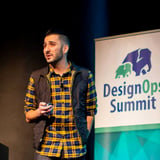Log in or create a free Rosenverse account to watch this video.
Log in Create free account100s of community videos are available to free members. Conference talks are generally available to Gold members.
Summary
How do we coordinate people for complex challenges? Certainly not with traditional work structures, designed to optimize for performance. Rather, we need new ways of working—new structures—that have been specifically designed to coordinate people for understanding. We'll look at a framework that can be used by teams, organizations, and other groups of humans working on complex problems. Stephen P. Anderson is a speaker and author who spends too much thinking about visual collaboration, how people learn, and board games; not necessarily in that order. Oh, and he’s on a mission: To make learning the hard stuff fun, by creating ‘things to think with’ and ‘spaces’ for generative play. This mission has led Stephen to MURAL, where he facilitates design strategy and innovation. Stephen's newest book, Figure It Out: Getting From Information to Understanding, has been described as both “required reading for designers and anyone else who needs to explain things” and a book that will “change the way you see the world.”
Key Insights
-
•
Complex problems differ fundamentally from complicated problems by involving unknown variables, shifting participants, and unclear success criteria.
-
•
Traditional top-down management structures often fail to coordinate people effectively on complex challenges.
-
•
Just enough structure—no more—is vital to prevent both chaos and rigid control when coordinating teams.
-
•
Cultivating shared language and standards is crucial; vague or specialized language can hinder true agreement and alignment.
-
•
Invisible environments like shared vision, mission, and values shape team coordination but must be actively lived, not just documented.
-
•
Designing visible environments—physical or virtual spaces—can shape group behavior and collaboration outcomes.
-
•
Psychological safety is foundational for teams to learn fast and innovate, emerging from deep listening, empathy, and interpersonal trust.
-
•
Accumulating multiple perspectives through drawing, analogies, and frameworks enriches understanding of complex challenges.
-
•
Adult development models explain why groups may act less mature than individuals, especially during frequent organizational resets.
-
•
Metaphors like gardening help in framing culture cultivation, emphasizing ongoing care, attention, and shared responsibility.
Notable Quotes
"All these traditional ways managers tell employees what to do probably don’t apply in complex problem contexts."
"We need just enough structure and no more to avoid chaos or stifling control."
"Until we clarify our language, we’ll agree on everything but not truly agree."
"Specialists would rather share their toothbrush than their language."
"The smartest person in the room is the room itself."
"Psychological safety isn’t created by an initiative but through a thousand tiny habits in language and behavior."
"If you want psychological safety, you have to start with self-awareness and deep listening."
"Teams often reset every 18 months and regress to infancy in trust and decision-making."
"A gardening metaphor fits culture better than cold, invisible icebergs because it highlights nurturing and growth."
"Drawing pictures together helps reduce interpretation and share perspectives effectively."
Or choose a question:
















More Videos

"For the first time, I was able to advocate for funding directly for the research function at high executive levels."
Nalini KotamrajuResearch After UX
March 25, 2024

"Don't be a pot plant, be a crab."
Dean BroadleyNot Black Enough to be White
January 8, 2024

"We’re not going for perfection. We’re going for excellence and change."
Denise Jacobs Nancy Douyon Renee Reid Lisa WelchmanInteractive Keynote: Social Change by Design
January 8, 2024

"Failure isn’t discouraging; it’s an opportunity to learn and improve your approach."
Kim Fellman CohenMeasuring the Designer Experience
October 23, 2019

"Not every project needs to be responded to; not every RFP needs a proposal."
George AyeThat Quiet Little Voice: When Design and Ethics Collide
November 16, 2022

"Google’s Material Design has echoes of design decisions flowing through many of their applications."
Nathan CurtisBeyond the Toolkit: Spreading a System Across People & Products
June 9, 2016

"There is an enormous amount of diversity in the real estate agent community, from demographics to technology savvy to regional differences."
Greg PetroffThe Compass Mission
March 10, 2021

"If you don’t do local research before launching a product, you risk disastrous failure."
Chloe Amos-EdkinsA Cultural Approach: Research in the Context of Glocalisation
March 27, 2023

"The new site had a 19% dropout rate compared to 32% on the old site, showing clear improvement."
Mackenzie Cockram Sara Branco Cunha Ian FranklinIntegrating Qualitative and Quantitative Research from Discovery to Live
December 16, 2022
















